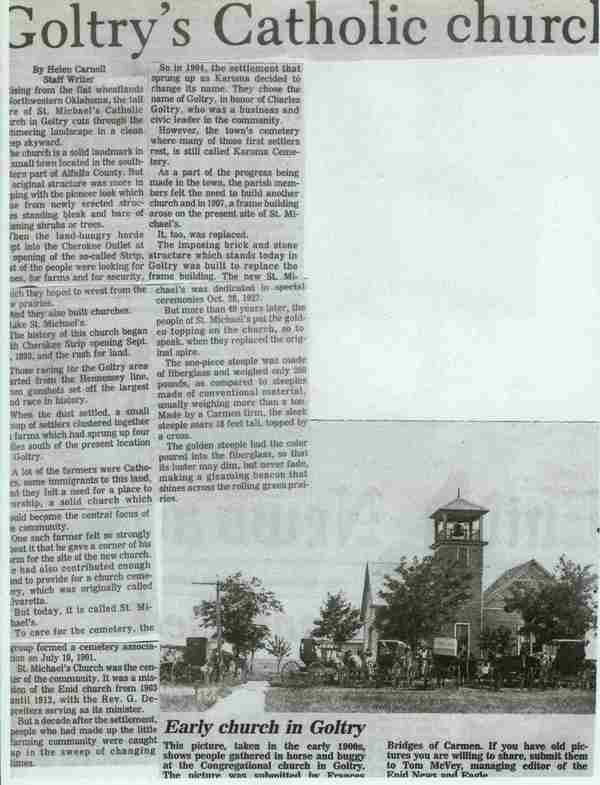|
Moderated by NW Okie! |
Volume 7 , Issue 462005Weekly eZine: (375 subscribers)Subscribe | Unsubscribe Using Desktop... |
Goltry's Catholic Church...

[news article from Enid News & Eagle, by Helen CArnell, staff writer.] -- Rising from the flat wheatlands of Northwestern Oklahoma, the tall spire of St. Michael's Catholic Church in Goltry cuts through the glimmering landscape in a clean sweep skyward.
The church is a solid landmark in a small town located in the southwestern part of Alfalfa County. But the original structure was more in keeping with the pioneer look which came from newly erected structures standing bleak and bare of ___tening shrubs of trees.
When the land-hungry horde swept into the Cherokee Outlet at the opening of the so-called Strip, first of the people were looking for homes, for farms and for security, which they hoped to wrest from the prairies. And they also built churchs. Like St. Michael's.
The history of this church began with Cherokee Strip opening Sept. 16, 1893, and the rush for land.
Those racing for the Goltry area started from the Hennessey line, when gunshots set off the largest land race in history.
When the dust settled, a small group of settlers clustered together on farms which had sprung up four miles south of the present location of Goltry.
A lot of the farmers were Catholics, some immigrants to this land, and they felt a need for a place to worship, a solid church which could become the central focus of the community.
One such farmer felt so strongly about it that he gave a corner of his farm for the site of the new church. He had also contributed enough land to provide for a church cemetery, which was originally called Alvaretta. But today, it is called St. Michael's.
To care for the cemetery, the group formed a cemetery association on July 10, 1901. St. Michael's Church was the center of the community. It was a mission of the Enid church from 1903 until 1912, with the Rev. G. Depreiters serving as its minister.
But a decade after the settlement, people who had made up the little farming community were caught up in the sweep of changing times.
So in 1904, the settlement that sprung up as Karoma decided to change its name. They chose the name of Goltry, in honor of Charles Goltry, who was a business and civic leader int he community.
However, the town's cemetery where many of those first settlers rest, is still called Karoma Cemetery.
As a part of the progress being made in the town, the parish members felt the need to build another church and in 1907, a frame building arose on the present site of St. Michael's.
It, too, was replaced.
The imposing brick and stone structure which stands today in Goltry was built to replace the frame building. The new St. Michael's was dedicated in special ceremonies Oct. 28, 1927.
But more than 40 years later, the people of St. Michael's put the golden topping on the church, so to speak, when they replaced the original spire.
The one-piece steeple was made of fiberglass and weighed only 250 pounds, as compared to steeples made of conventional material, usually weighing more than a ton. Made by a Carmen firm, the sleek steeple soars 18 feet tal, topped by a cross.
The golden steeple had the color poured into the fiberglass, so that its luster may dim, but never fade, making a gleaming beacon that shines across the rolling green prairies.
| View or Add Comments (0 Comments)
| Receive
updates ( subscribers) |
Unsubscribe
| © . Linda Mcgill Wagner - began © 1999 Contact Me | |
